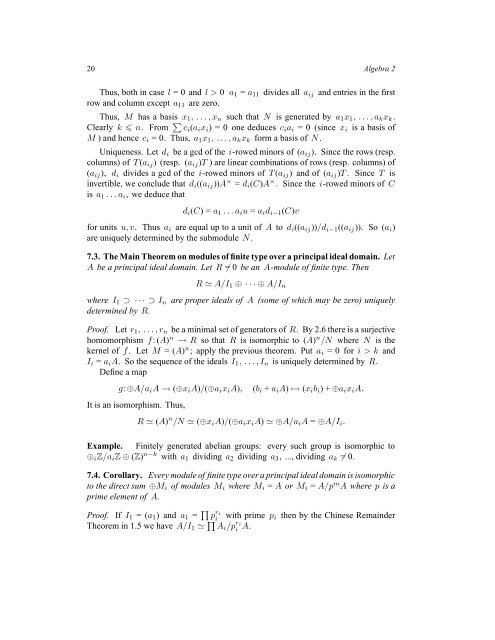Algebra (Unknown 27). - Index of
Algebra (Unknown 27). - Index of
Algebra (Unknown 27). - Index of
You also want an ePaper? Increase the reach of your titles
YUMPU automatically turns print PDFs into web optimized ePapers that Google loves.
20 <strong>Algebra</strong> 2<br />
Thus, both in case l = 0 and l > 0 a 1 = a 11 divides all a ij and entries in the first<br />
row and column except a 11 are zero.<br />
Thus, M has a basis x 1 , . . . , x n such that N is generated by a 1 x 1 , . . . , a k x k .<br />
Clearly k n. From ∑ c i (a i x i ) = 0 one deduces c i a i = 0 (since x i is a basis <strong>of</strong><br />
M ) and hence c i = 0. Thus, a 1 x 1 , . . . , a k x k form a basis <strong>of</strong> N .<br />
Uniqueness. Let d i be a gcd <strong>of</strong> the i-rowed minors <strong>of</strong> (a ij ). Since the rows (resp.<br />
columns) <strong>of</strong> T (a ij ) (resp. (a ij )T ) are linear combinations <strong>of</strong> rows (resp. columns) <strong>of</strong><br />
(a ij ), d i divides a gcd <strong>of</strong> the i-rowed minors <strong>of</strong> T (a ij ) and <strong>of</strong> (a ij )T . Since T is<br />
invertible, we conclude that d i ((a ij ))A × = d i (C)A × . Since the i-rowed minors <strong>of</strong> C<br />
is a 1 . . . a i , we deduce that<br />
d i (C) = a 1 . . . a i u = a i d i−1 (C)v<br />
for units u, v. Thus a i are equal up to a unit <strong>of</strong> A to d i ((a ij ))/d i−1 ((a ij )). So (a i )<br />
are uniquely determined by the submodule N .<br />
7.3. The Main Theorem on modules <strong>of</strong> finite type over a principal ideal domain. Let<br />
A be a principal ideal domain. Let R ≠ 0 be an A-module <strong>of</strong> finite type. Then<br />
R ≃ A/I 1 ⊕ · · · ⊕ A/I n<br />
where I 1 ⊃ · · · ⊃ I n are proper ideals <strong>of</strong> A (some <strong>of</strong> which may be zero) uniquely<br />
determined by R.<br />
Pro<strong>of</strong>. Let r 1 , . . . , r n be a minimal set <strong>of</strong> generators <strong>of</strong> R. By 2.6 there is a surjective<br />
homomorphism f: (A) n → R so that R is isomorphic to (A) n /N where N is the<br />
kernel <strong>of</strong> f . Let M = (A) n ; apply the previous theorem. Put a i = 0 for i > k and<br />
I i = a i A. So the sequence <strong>of</strong> the ideals I 1 , . . . , I n is uniquely determined by R.<br />
Define a map<br />
g: ⊕A/a i A → (⊕x i A)/(⊕a i x i A), (b i + a i A) ↦→ (x i b i ) + ⊕a i x i A.<br />
It is an isomorphism. Thus,<br />
R ≃ (A) n /N ≃ (⊕x i A)/(⊕a i x i A) ≃ ⊕A/a i A = ⊕A/I i .<br />
Example. Finitely generated abelian groups: every such group is isomorphic to<br />
⊕ i Z/a i Z ⊕ (Z) n−k with a 1 dividing a 2 dividing a 3 , ..., dividing a k ≠ 0.<br />
7.4. Corollary. Every module <strong>of</strong> finite type over a principal ideal domain is isomorphic<br />
to the direct sum ⊕M i <strong>of</strong> modules M i where M i = A or M i = A/p m A where p is a<br />
prime element <strong>of</strong> A.<br />
Pro<strong>of</strong>. If I 1 = (a 1 ) and a 1 = ∏ p r i<br />
i with prime p i then by the Chinese Remainder<br />
Theorem in 1.5 we have A/I 1 ≃ ∏ A i /p r i<br />
i A.

















